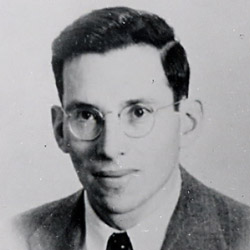George Koval was an American chemical engineer and one of the most important Soviet spies of the 20th century.
Koval was born in Sioux City, Iowa to a family of immigrants from Belarus, then part of the Russian Empire. Koval’s parents raised George and his two other brothers in Sioux City until 1932, when in the midst of the Great Depression, the family moved to the Soviet Union in search of a more promising life.
In Russia, the Kovals joined a collective farm. There, George quickly distinguished himself as one of the commune’s most talented members; after improving his Russian, he taught himself how to repair the farm’s machinery and became the collective’s primary mechanic. After attending the Mendeleev Institute of Chemical Technology in Moscow, Koval caught the attention of Soviet Union’s Main Intelligence Directorate (GRU). At some point, he was recruited by the GRU and received specialized training to carry out espionage missions in the United States.
Spying
In 1939, the G.R.U. assigned Koval the codename “Delmar” and instructed him to return to the United States. He eventually made his way to New York City, where he assumed deputy command of the GRU station there. Soon, however, Koval was drafted into the United States Army and was eventually accepted into the Army’s Specialized Training Program (ASTP). For the next eight months, Koval studied electrical engineering at the City College of New York (CCNY) before being selected for the Army’s Special Engineer Detachment (SED) in August of 1944.
Later that month, Koval arrived in Oak Ridge, where he was made a Health Physics officer. That position, according to FBI files, gave him top-secret clearance. Over the next several months, Koval passed secret information about Oak Ridge’s nuclear facilities to a Soviet contact known only by his code-name, “Farraday.”
In June 1945, Koval was transferred again, this time to a top-secret laboratory in Dayton, Ohio. This may have been his most damaging placement; it was there that the polonium-based “initiator” for the implosion bomb was being developed. Once again, Koval was made a health physics officer and enjoyed free access to the site’s secret facilities.
Between 1945 and early 1946, Koval met regularly with his Soviet contact, code-named Clyde, to pass along detailed information about the polonium work being done at Dayton. On February 13, 1946, the GRU received a report from Koval that included a brief description of the manufacturing process of polonium.
Later Years
In 1946, Koval was honorably discharged from the Army. Shortly thereafter, he returned to New York and to CCNY, where he received his bachelor’s degree in electrical engineering cum laude on February 1, 1948. Later that year, Koval sailed for Europe, never to return.
Koval’s story has only recently come to light. On November 2, 2007, Russian Prime Minister Vladimir Putin posthumously awarded Koval with the Hero of the Russian Medal, the nation’s highest civilian honor, for “his courage and heroism while carrying out special missions” and acknowledged Koval’s contribution to the Soviet Union’s development of the atomic bomb. According to the Kremlin’s press release, Koval was the “only Soviet intelligence officer to penetrate the U.S. secret atomic facilities producing the plutonium, enriched uranium and polonium used to create the atomic bomb.”
Further Reading
For more information about Koval, check out “The Spy Who Stole Urchin” by Owen Pagano, an intern at the Atomic Heritage Foundation who became interested in Koval and wrote his undergraduate thesis on the topic.





